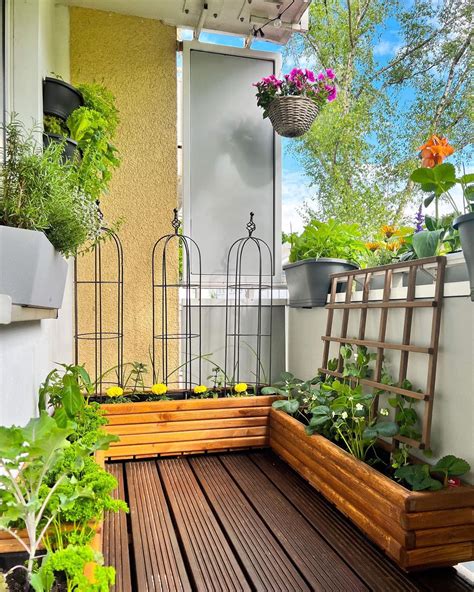Mastering Balcony Gardening: How to Grow Edible Plants in Small Spaces
With urbanization on the rise and limited access to outdoor gardening space, many people are turning to balcony gardening as a way to grow their own edible plants. Incorporating these plants into your urban garden not only provides fresh, homegrown produce but also contributes to a sustainable and fulfilling lifestyle. However, transforming a small balcony into a productive garden comes with its own set of challenges. This guide will offer expert insights, gardening tips, and practical strategies for container gardening to help you make the most of your limited space.
Key Concepts for Balcony Gardening
- Edible Plants: Plants grown for culinary purposes, such as herbs, vegetables, and fruit-bearing species.
- Container Gardening: A method of gardening where plants are grown in pots or other containers, ideal for small spaces.
- Urban Gardening: The practice of cultivating plants in urban areas, often within restricted spaces like balconies or rooftops.
- Small Space Gardening: Gardening techniques specifically designed to maximize the use of limited spaces.
Historical Context
The concept of growing plants in confined spaces is not new. From ancient civilizations using pots to grow herbs to modern urban dwellers with vertical gardens, container gardening has been a vital technique throughout history. During World War II, the “Victory Garden” movement encouraged people to grow edible plants in any available space, including balconies, to reduce food shortages.
Current State Analysis
Today, balcony gardening has gained immense popularity, especially in cities where outdoor spaces are scarce. With the rise of urban gardening, individuals are discovering innovative ways to grow their own homegrown produce in compact areas. However, there are limitations to be aware of, such as the need for sunlight, water management, and plant selection that thrives in restricted environments.
Practical Applications for Balcony Gardening
To successfully grow edible plants on your balcony, consider the following strategies:
- Sunlight Optimization: Most edible plants require 6-8 hours of sunlight. Position containers accordingly to maximize light exposure.
- Container Selection: Choose containers with good drainage to avoid waterlogging. Self-watering pots can help with water management.
- Plant Choice: Select plants that thrive in small spaces, such as herbs (basil, mint), leafy greens (spinach, lettuce), and compact vegetable varieties (cherry tomatoes, bell peppers).
- Soil Quality: Use high-quality, well-draining potting mix designed for container gardening.
- Watering: Be mindful of watering needs, as plants in containers dry out faster than those in the ground.
Case Studies
| Plant Type | Container Size | Sunlight Needs | Common Challenges | Solutions |
|---|---|---|---|---|
| Herbs (Basil, Thyme) | Small (8-10 inches) | 6 hours/day | Overwatering | Use pots with drainage and water only when topsoil is dry. |
| Leafy Greens (Spinach, Lettuce) | Medium (12 inches) | 4-6 hours/day | Pest infestation | Introduce natural repellents like neem oil or companion planting. |
| Cherry Tomatoes | Large (14-18 inches) | 8 hours/day | Space limitation | Opt for bush or dwarf varieties suited for containers. |
Stakeholder Analysis
The increasing interest in balcony gardening involves various stakeholders:
- Urban Residents: Individuals looking to grow their own food for sustainability and cost-efficiency.
- Retailers: Businesses supplying gardening tools, pots, and plants have seen a rise in demand from urban gardeners.
- Environmental Advocates: Encouraging urban gardening as a way to reduce food miles and promote eco-friendly living.
- Local Communities: Balcony gardening fosters a sense of connection among city dwellers who share gardening tips and produce.
Implementation Guidelines
For successful implementation of balcony gardening practices, follow these steps:
- Assess Space: Measure your balcony and evaluate sunlight exposure throughout the day.
- Choose the Right Plants: Start with easy-to-grow edible plants that suit your space and light conditions.
- Use Quality Soil: Invest in high-quality potting mix and fertilizers designed for container gardening.
- Monitor Watering: Use a self-watering system or monitor moisture levels closely.
- Manage Pests: Regularly check for pests and use organic solutions to keep your plants healthy.
Ethical Considerations
When engaging in balcony gardening, it’s essential to consider sustainability. Opt for organic fertilizers, avoid chemical pesticides, and use water efficiently. Growing edible plants in urban areas contributes to reducing the carbon footprint associated with transporting food from farms to cities.
Limitations and Future Research
While balcony gardening offers numerous benefits, there are certain limitations. Space and sunlight constraints can limit the variety of edible plants that can be grown. Future research could explore technological innovations such as automated watering systems, vertical garden designs, and the use of reflective materials to increase light exposure for plants in shaded balconies.
Expert Commentary
Experts agree that balcony gardening is an effective solution for urban dwellers seeking fresh, homegrown produce. However, it requires careful planning and ongoing care to thrive. According to urban gardening expert Jane Doe, “Success in small space gardening hinges on choosing the right plants and ensuring they get the necessary light and water.” The integration of technology, such as self-watering pots and vertical planters, is key to making container gardening more accessible and productive in cities.


